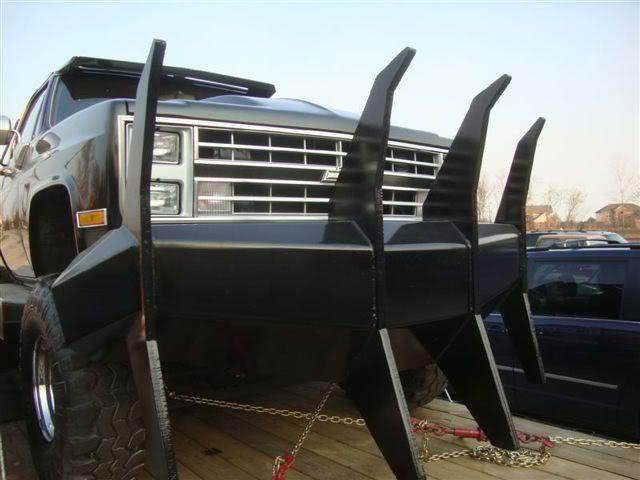Today, I was leaving the store and what drove by neatly captured America’s attitude towards pedestrians. It was an F350 outfitted with a heavily customized “Iron Cross” front bumper with actual spikes.

The above isn’t the actual truck, which I didn’t catch a photo of in time, but it looked similar (Reddit source). Why is he allowed to drive this thing in public? Easy: because he can.
Given the country’s anemic pedestrian protection laws, someone wanting to drive a dangerous vehicle has wide latitude. We’re decades behind many countries in establishing basic protections and are fighting a pervasive attitude that pedestrians really don’t matter. It’s not just that the US is car-loving, and much urban planning revolves around it. Many folks are outright anti-pedestrian.
While people will concede to having sidewalks, they’re annoyed when pedestrians might want to cross busier roads. Pedestrian right-of-way laws are often mocked and regularly ignored. In my neighborhood, we have a marked crosswalk across a busier road that is nearly impossible to use during rush hour. People won’t even notice that you’re trying to cross. My attempts at getting a crossing light installed (for improved visibility) haven’t yielded much. The opposition is from the county: the flashing light might cause traffic to back up which could also affect cars on an intersecting, larger highway. The priority here is pretty clear. Yes, the pedestrian has the right of way, but it’s really up to them to figure out how to exercise that right without getting killed.
Back to our friend with the Mad Max-inspired truck. US trucks (and some cars) are commonly equipped with more modest bullbars which greatly increase the danger to pedestrians. (As if it isn’t already dangerous enough with everyone driving a monster truck?) Illegal or heavily regulated in many countries, they’re commonplace here. What value do these provide to the suburbanites I see driving around the neighborhood? Simple: they complete the rugged, macho picture. I constantly see huge trucks adorned with outdoorsy accessories like winches, fuel tanks, and bullbars. Maybe these see use in the wilderness occasionally, but more likely they’re used to pick up groceries, or the kids.
Changing individual attitudes and culture is a tough, long-term effort. But there are other more well-defined opportunities for improvement. The biggest is the trucking industry. Truck side guards are ubiquitous (and often required by law) in many countries and have been shown to substantially reduce the chance of fatal injury to cyclists and vehicles in the event of a collision. But in the US, you rarely see them.

The difference between a cyclist deflecting off versus going under this truck is pretty obvious. Advocacy campaigns (e.g. The Jessica Campaign) for side guards are often prompted by tragedies involving cyclists. When folks learn how a simple modification could have prevented the worst, there is interest in taking action.
Less obvious is the protection also afforded to those in cars that a side (or rear) guard can make. This test demonstration dramatically shows how a side guard can mean the difference between a survivable collision and being decapitated.
These devices are not particularly costly and can be retrofitted easily. When I was in London last summer, I noticed that even small trucks with a little ground clearance would have side guards. The US lags far behind despite government-funded studies about their efficacy and recommendations supporting them. The reason is, of course, a history of industry lobbying against them. This isn’t a surprise, given the disregard for pedestrian safety, even at an individual level.
But, at least on the side-guard issue, there is some movement. Individual municipalities are taking action, and there is technical support from the government (e.g. Volpe) to help with these efforts. Changing the culture and attitudes will take longer and starts with awareness (hence this blog post). I look forward to the day pedestrian safety is viewed as an obligation, not a nuisance.